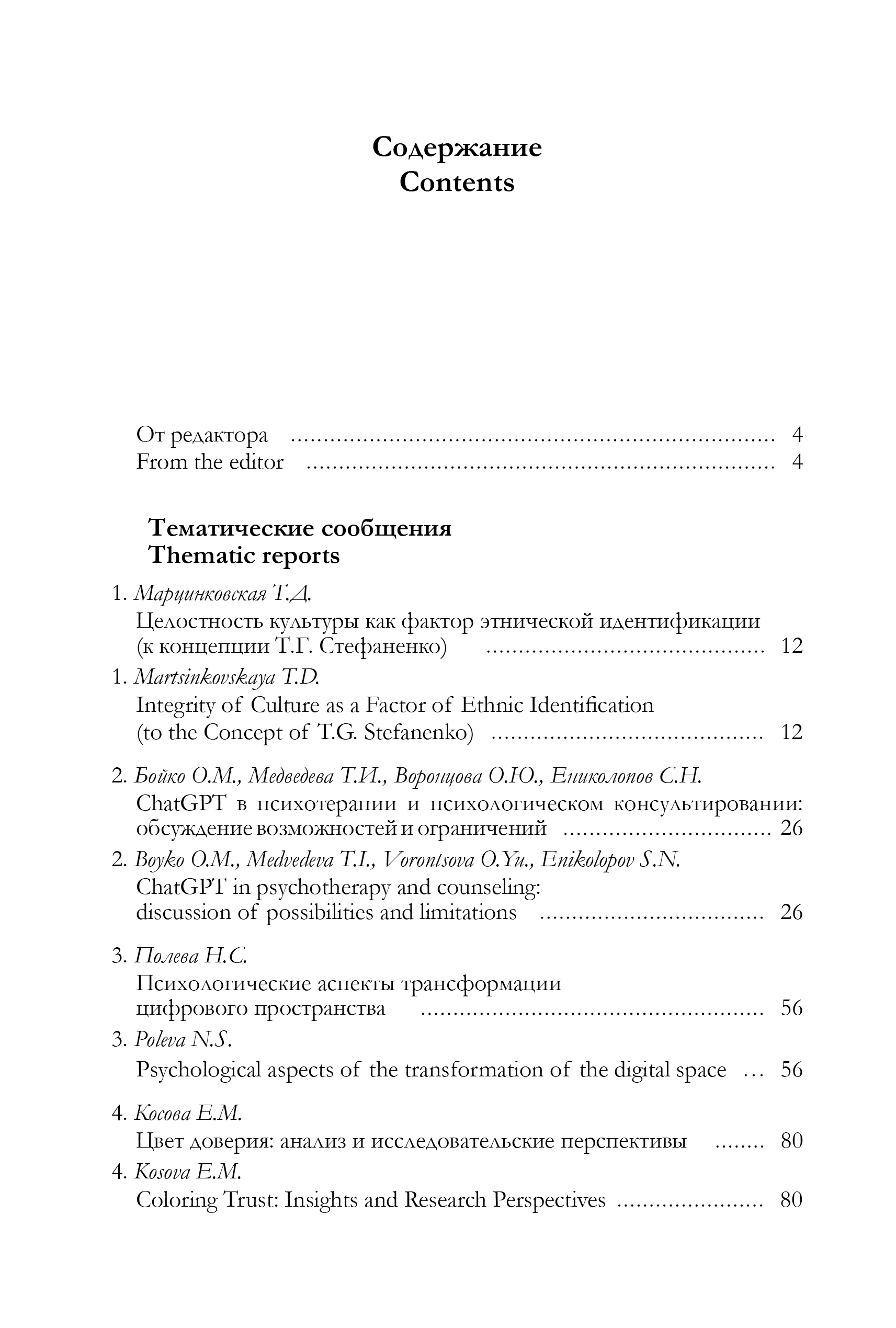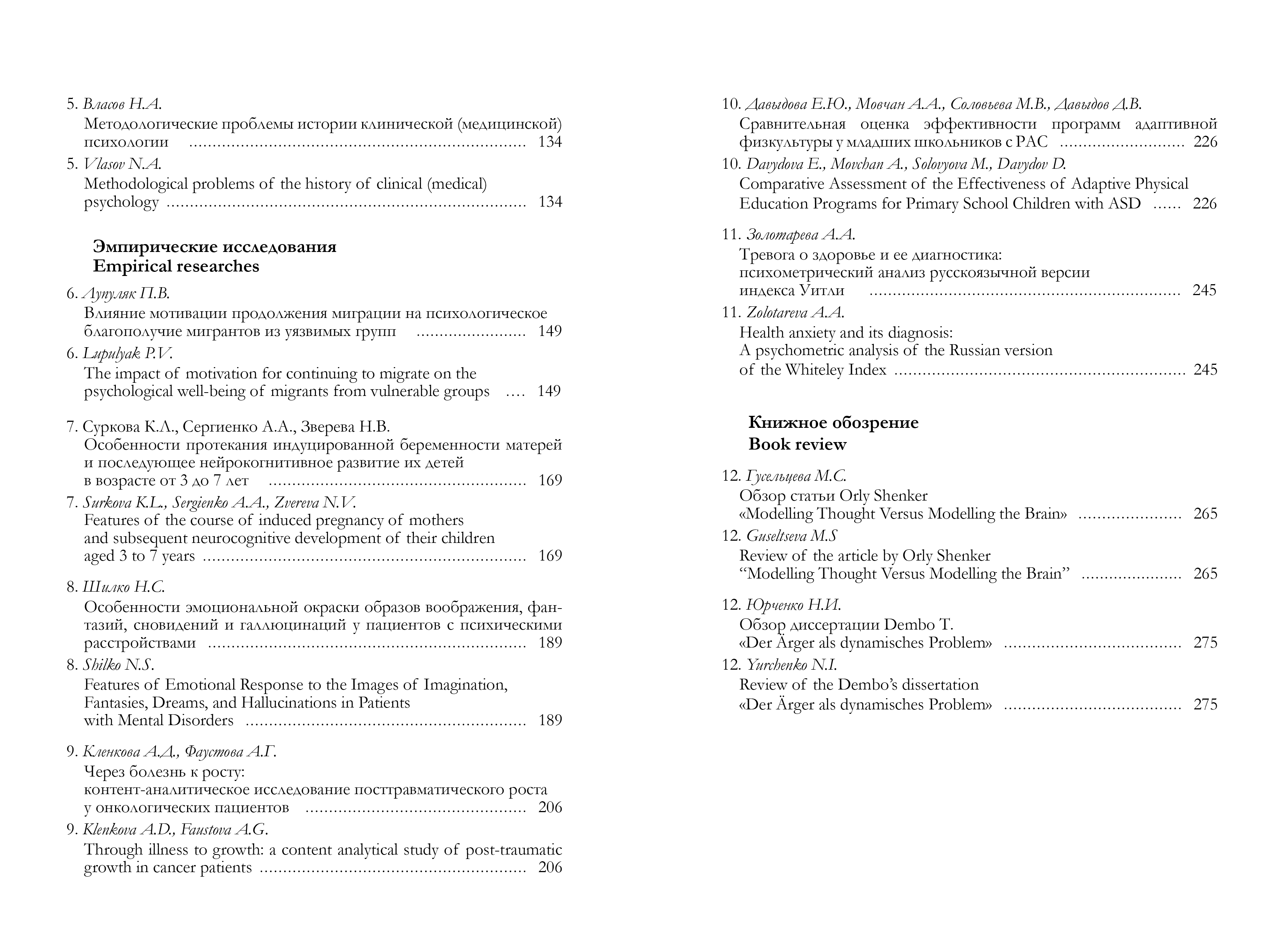From the Editor
Editor-in-chief of the journal «New psychological research» T. D. Martsinkovskaya, Moscow, 8 April 2025
Dear colleagues, I present the first issue of the journal and congratulate everyone with spring!
This issue opens with an article by T.D. Martsinkovskaya dedicated to the work of the remarkable scientist, ethno psychologist T.G. Stefanenko. This is a continuation of the publications of the previous issue, in which we remembered our teachers and friends. This article emphasizes that the most important provision of T.G. Stefanenko's concept was a new approach to understanding culture as a factor of the formation of ethnic identity, its arbitrariness and variability. The separation of the concepts of ethnic and cultural identification and identity (as a process and a result) determined the ideas about the freedom to choose one's identity and the importance of mutual acceptance of a person and a group. Understanding culture as an integral system with moving boundaries is currently becoming the basis for an interdisciplinary approach to understanding ethnic identity and helps to connect different forms of identity and the integrity of the individual in a changing society.
In the article by Boyko O.M., Medvedeva T.I., Vorontsova O.Yu., Enikolopov S.N. “ChatGPT in psychotherapy and counseling: discussion of possibilities and limitations” are analyzed the advantages, disadvantages and limitations of using ChatGPT in psychotherapeutic practice. It is shown that AI can complement traditional mental health care, but the current development of AI does not allow it to be considered as a replacement for a specialist. The authors present the results of a small empirical study aimed at interpreting ChatGPT responses to requests for psychological help and information on psychiatric diagnoses and medicine treatment. In general, it is concluded that studies of the long-term effectiveness and safety of AI interventions are needed.
N. S. Poleva in the article “Psychological aspects of the transformation of the digital space” considers the features of the current stage of the Internet evolution. The reasons for users' desire to create closed chats or mini-communities, such as "Dark Forests" or Cozyweb, are analyzed. It is shown that in these social networks, the experience of precarity decreases and psychological resilience increases. It is concluded that the Internet helps to individualize a person and create a safe space for communication, self-realization, generation of new meanings and values.
The article by E.M. Kosovaya “The color of trust: analysis and research prospects” focuses on the analysis of classical and modern studies devoted to the influence of color on the level of trust. The article offers a theoretical basis for studying the relationship between color and trust, and discusses new areas of work related, in particular, to the emergence of virtual and augmented reality. The materials presented in the article help to better understand the role of color in the context of trust.
The article by N.A. Vlasov “Methodological problems of the history of clinical (medical) psychology” presents an analysis of the methodological problems of the history of clinical psychology, and proposes four possible solutions. It is shown that a comprehensive study of the history of clinical (medical) psychology is possible only with a comprehensive consideration of various aspects of its development and the use of various historical and psychological methods.
The article by P.V. Lupulyak “The impact of motivation for continuing to migrate on the psychological well-being of migrants from vulnerable groups” examines the actual problem of migrant vulnerability. The article observes the concept of "vulnerability", considers the typology of vulnerable groups, and presents the results of cross-cultural studies comparing migrant and non-migrant groups. Such qualities of migrants as resilience and hardiness are highlighted. It was found that the factors of vulnerability and the semantic self-explanation of continued migration influence psychological well-being separately, but they do not exert a joint influence. A new approach to the problem of vulnerability during migration is proposed, which proves that the motivation to continue migration is a key link in studying the psychological well-being of migrants.
Article by K.L. Surkova, A.A. Sergienko and N.V. Zvereva's “Features of the course of induced pregnancy of mothers and subsequent neurocognitive development of their children aged 3 to 7 years” is devoted to the study of neurocognitive development of children depending on the characteristics of the course mother’s pregnancy. The materials of the work present the results of the analysis of the course of pregnancy with artificial and natural fertilization in comparison with the indicators of neurocognitive development of a child aged 3-7 years. It is shown that in children conceived with the help of assisted reproduction, the negative impact of an aggravated pregnancy on neurocognitive development is more pronounced than in children of natural conception.
In the article by N.S. Shilko “Features of Emotional Response to the Images of Imagination, Fantasies, Dreams, and Hallucinations in Patients with Mental Disorders” the results of the study of differences in the emotional coloring of various images in patients with psychotic and non-psychotic disorders compared to mentally healthy people are presented. The obtained materials showed that patients with psychotic disorders experience predominantly negative emotions from imagination, while patients with non-psychotic disorders, like healthy people, experience predominantly positive ones.
The article by A.D. Klenkova and A.G. Faustova “Through illness to growth: a content-analytical study of post-traumatic growth in cancer patients” is devoted to the analysis of manifestations of post-traumatic growth in cancer patients using the content analysis method. The obtained materials showed that the most common manifestations of post-traumatic growth are from the categories of “new opportunities” and “increasing the value of life”. The results also prove the complexity and versatility of the phenomenon of post-traumatic growth.
The work of Davydova E., Movchan A., Solovyova M., Davydov D. “Comparative Assessment of the Effectiveness of Adaptive Physical Education Programs for Primary School Children with ASD” is devoted to a comparative analysis of the efficiency of standard and adapted physical education programs and testing the “PhizRas” method for assessing the motor sphere of children with ASD. The results showed greater efficiency of the “Out Fitness” program in improving motor and everyday skills in children with ASD compared to traditional physical education classes. This method also makes it possible to take into account both physical and communicative aspects of development.
The article by A.A. Zolotareva “Health anxiety and its diagnosis: A psychometric analysis of the Russian version of the Whiteley Index” presents the results of adaptation and psychometric analysis of the Russian-language version of the Whitley Index (WI). The adaptation results confirmed the factorial validity, factorial invariance, internal reliability, convergent validity and criterion validity of the Russian-language version of the Whitley Index. Thus, the adapted version of the Whitley index can be recommended for assessing health anxiety in the general Russian-speaking population.
In the work of M.S. Gusel'tseva, an overview of the article by Orly Shenker “Modelling Thought Versus Modelling the Brain” is given. The article discusses the connection between modelling of thought and modelling of the brain. The result of Orly Shenker's reflections was the conclusion that the ideas of multiple feasibility, despite their prevalence and attractiveness in neuroscience, require revision and justification, since correct modelling of thinking is hardly possible in modern science.
N.I. Yurchenko provides an overview of the dissertation of Dembo T. “Der Ärger als dynamisches Problem”. This work by T. Dembo was included in the book by K. Levin “Dynamic Psychology” in the last part, where the works of his students are given, including T. Dembo. But since many provisions of her work remain relevant and little known, including due to the fact that the remarkable book “Dynamic Psychology” has become a rare edition, we decided that it would be appropriate to provide a brief overview of T. Dembo's work. T. Dembo identifies several stages of anger development: from the first attempts to complete a task to affective reactions such as throwing objects or leaving the room. The work also examines various types of reactions to frustration – real, unreal and substitute solutions. Despite the fact that the experiments were conducted in laboratory conditions, Dembo claims that the identified patterns are universal and apply to real life situations.



Received: 08th april 2025
Published: 08th april 2025